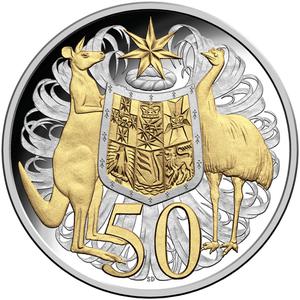Fifty Cents (Round, NCLT), Coin Type from Australia - detailed information
| ||||
The Australian 50 cent denomination was first introduced as a silver coin with decimalisation on 14 February 1966, but was changed in 1969 to its current specifications: a large dodecagonal (12-sided) copper-nickel coin; apart from the usual design featuring the Australian Coat of Arms (by Stuart Devlin) which has not been changed since its introduction, the denomination is also often used to issue circulating commemorative coins with various reverses. It is one of the heaviest coins in regular circulation in the world. Apart from the circulating coinage, the Royal Australian Mint has an extensive program issuing 50 cent coins for collectors (Non-Circulating Legal Tender, or NCLT). Some of them are round, as reference to the original format of the denomination. | ||||
| ||||
| ||||
| ||||
| ||||
| ||||
 |
| The Definitive Guide to Australian Silver Coins |
| Coin Name | Reverse | Obverse | Details |
|---|---|---|---|
| Fifty Cents 1998 (Silver, Crown) |
Material: 0.999 Silver Mint: Royal Australian Mint Mintage: 15,000 |
||
| Fifty Cents 1999 (Silver, Sixpence) |
Material: 0.9999 Silver Mint: Royal Australian Mint Mintage: 15,000 |
||
| Fifty Cents 2000 (Silver, King George VI) |
Material: 0.999 Silver Mint: Royal Australian Mint Mintage: 10,412 |
||
| Fifty Cents 2006 (Silver, Second Portrait) |
Material: 0.999 Silver Mint: Royal Australian Mint Mintage: 5,829 |
||
| Fifty Cents 2016 Round |  |
 |
Material: Gold plated copper-nickel Mint: Royal Australian Mint Mintage: 21,966 |
 |
| Buy Silver Coins Online |
| Country | Australia |
|---|---|
| Currency | Australian Dollar |
| Sub-type of | Fifty Cents, NCLT |
| From | 1999 |
| Face Value | 50 (x Cent) |
| Current | Yes |
| Material | Silver |
| Designer | |
| Technology | Milled (machine-made) |
| Shape | Round |
| Orientation | Medal Alignment (Axis 0) |
| Size | 31.6500 mm |
| Mass | 15.5500 g |


